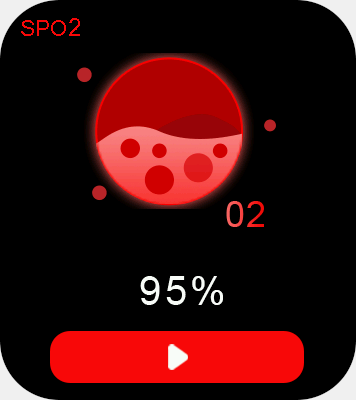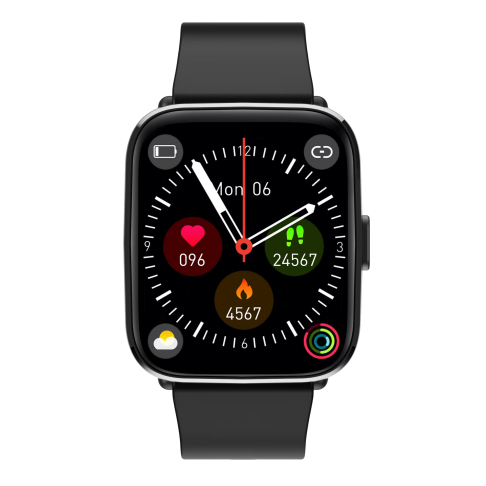Smartwatch, bracelet heart rate, blood oxygen really reliable?
Today's smartwatches don't just help us measure our steps. They also help us measure our heart rate and VO2 Max, giving us more insight into our fitness and ability to exercise. But the data doesn't speak for itself. How can you use this data to better understand your body?
Although these indicators are also introduced in the mobile app of smartwatch collocation, watch manufacturers simplify part of the content to make it easier for the public to understand, and simplification means distortion. Other metrics, such as dynamic VO2 Max, are of little practical use to users, and to understand why they are of little use requires a better understanding of Max.

Heart rate
The definition of heart rate is simple, namely the number of heart beats per minute. Beats per minute is commonly used as the unit of heart rate in English.
01 How does the watch Obtain the heart rate?
In normal people (not in atrial fibrillation), the heartbeat corresponds to the pulse, one heartbeat for each pulse. So we can usually tell the heart rate by tapping the pulse at the wrist. How does a watch measure it? Do you have a baroreceptor on your watch that feels the different pressures of your pulse to calculate your pulse?
This sentence is half right, the watch is also based on the periodic pulse changes to speculate the heart rate, but the watch is not to feel pressure changes, but through the light to feel the blood changes to get the heart rate, this method is called photoplethysmographic (PPG) professional name. PPG is a compound of Photo (light), Plethysmos (change), and Graphos (record). Literally, it's a measurement that uses light to record changes in arteries as they pass through parts of the body.
So, what is a pulse wave? Pulse wave refers to the microscopic changes in blood vessels as the heart contracts and expands during blood circulation. PPG is a measurement that identifies these pulse waves as waveforms. Simply put, the heart contracts and dilates alternately, the blood flow in the blood vessels increases and decreases repeatedly, and the composition of the blood changes. The method of detecting reflected or transmitted light by emitting a light source into the skin is PPG. The following diagram shows the basic principle and process of PPG measurement.

PPG measures not only heart rate but also oxygen saturation, blood pressure and respiration rate. The following diagram shows the PPG signal can obtain different physiological indicators. Different wavelengths are used to obtain different PPG indicators. Because hemoglobin absorbs more red light, red light and near-infrared light are preferred when measuring blood oxygen saturation. On the other hand, red light is more disturbed by exercise, so green light is more used when measuring heart rate. Green light also has its disadvantages. Green light is greatly affected by sweat. Therefore, in practical practice, many manufacturers will use a variety of light sources to measure heart rate, blood pressure and other parameters.

Is 02 watch accurate to measure heart rate?
Heart rate detection is the most mature technology in PPG, and the measurement results are relatively accurate. In the case of the Apple Watch and Fibit, the study showed little difference between the watch and an electrocardiogram measuring heart rate. However, the value of heart rate measured by the watch is generally lower than that measured by the laboratory, about 0.9-7.2 times, and the Apple Watch is about 1.3 times lower than the gold standard in the experiment. I personally in the use of several domestic watches (bracelets), also feel the watch to measure the heart rate is more accurate. But there is a big delay in the heart rate display of the watch. Often my heart rate reaches 140, and it takes 5-10s for the heart rate of the watch to slowly climb up to my actual heart rate.
While watches are accurate in the general population, heart rate measurements can be compromised in some groups, such as skin color and obesity. Ajmal used the microvascular model to simulate the influence of skin color and obesity on the measurement results of PPG heart rate, and found that the fluctuation of PPG value was 10% when only considering the change of skin color, but the fluctuation of PPG signal was as high as 61.2% when considering the influence of skin color and obesity. The reason is that darker skin has higher melanin which absorbs more light. Moreover, the skin of obese people tends to be thicker than that of non-obese people, with less moisture and less blood flow leading to a larger deviation in PPG.
What information can 03 help us learn?
Heart rate indicators are common and can tell you a lot about exercise health. According to the American Heart Association, a normal adult's resting heart rate (the heart rate at rest) is between 60 and 100bpm. A resting heart rate of more than 100 beats is called tachycardia, less than 60 beats is bradycardia, and irregular beats are called arrhythmias.
From left to right, an electrocardiogram of tachycardia, bradycardia, and irregular heart rhythms is shown on Wikipedia.
But it turns out that a resting heart rate greater than 80 increases health risks. One study found that a resting heart rate greater than 80bpm was associated with a 33% increased risk of cardiovascular mortality and 45% increased risk of all-cause mortality. A large prospective study of 1 million men in Sweden found that an elevated resting heart rate in late adolescence was associated with an increased risk of obsessive-compulsive disorder, anxiety diagnosis and schizophrenia, while a low heart rate was associated with substance abuse and violence.
But a resting heart rate of less than 60 isn't necessarily a health risk. It can also be a sign of training adaptation. People who exercise regularly may have a resting heart rate of less than 60bpm because their heart muscle is more powerful and can pump more blood per heartbeat, thus satisfying the circulation of blood throughout the body at a lower heartbeat. Some elite swimmers, for example, have resting heart rates as low as 38 beats, making them "big hearts".
Sports Category
Heart rate is often used to reflect not only fitness but also exercise intensity. The more vigorous the exercise, the faster the heart rate. That, in turn, allows us to quantify the intensity of our exercise based on our current heart rate. With the increase of exercise intensity, the heart rate will not increase indefinitely, but will have a maximum value. Generally, we will determine the exercise intensity by calculating the ratio of the heart rate during exercise to the maximum heart rate.
Determining the intensity of exercise is essential for scientific and efficient exercise. Once we can judge the intensity of exercise, we can prescribe exercise and target it more. People often wonder which form of exercise can help them lose weight. For example, can jumping rope help them lose weight? Can you Lose Weight by Running and dancing? In fact, whether you can lose weight or not has nothing to do with the type of exercise, but mainly with the intensity and duration of exercise. The body doesn't know if we're dancing or running, it just recognizes intensity. As long as you exercise at a moderate intensity for enough time, you can lose fat.
Post time: Dec-16-2022

